NCERT Solutions Class 11 Maths Chapter 8 - Sequence And Series
Question 1: If f is a function satisfying  such that
such that  , find the value of n.
, find the value of n.
ANSWER : It is given that,
f (x + y) = f (x) × f (y) for all x, y ∈ N … (1)
f (1) = 3
Taking x = y = 1 in (1), we obtain
f (1 +1) = f (2) = f (1) f (1) = 3 × 3 = 9
Similarly,
f (1 +1 +1) = f (3) = f (1 +2) = f (1) f (2) = 3 × 9 = 27
f (4) = f (1 +3) = f (1) f (3) = 3 × 27 = 81
∴ f (1), f (2), f (3), …, that is 3, 9, 27, …, forms a G.P. with both the first term and common ratio equal to 3.
It is known that, 
It is given that, 
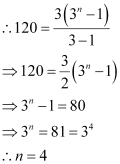
Thus, the value of n is 4.
Question 2: The sum of some terms of G.P. is 315 whose first term and the common ratio are 5 and 2, respectively. Find the last term and the number of terms.
ANSWER : Let the sum of n terms of the G.P. be 315.
It is known that, 
It is given that the first term a is 5 and common ratio r is 2.
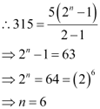
∴Last term of the G.P = 6th term = ar6 – 1 = (5)(2)5 = (5)(32) = 160
Thus, the last term of the G.P. is 160.
Question 3: The first term of a G.P. is 1. The sum of the third term & fifth term is 90. Find the common ratio of G.P.
ANSWER : Let a and r be the first term and the common ratio of the G.P. respectively.
∴ a = 1
a3 = ar2 = r2
a5 = ar4 = r4
∴ r2 + r4 = 90
⇒ r4 + r2 – 90 = 0

Thus, the common ratio of the G.P. is ±3.
Question 4: The sum of three numbers in G.P. is 56. If we subtract 1, 7, 21 from these numbers in that order, we obtain an arithmetic progression. Find the numbers.
ANSWER : Let the three numbers in G.P. be a, ar, and ar2.
From the given condition, a + ar + ar2 = 56
⇒ a (1 + r + r2) = 56
 … (1)
… (1)
a – 1, ar – 7, ar2 – 21 forms an A.P.
∴(ar – 7) – (a – 1) = (ar2 – 21) – (ar – 7)
⇒ ar – a – 6 = ar2 – ar – 14
⇒ar2 – 2ar + a = 8
⇒ar2 – ar – ar + a = 8
⇒a(r2 + 1 – 2r) = 8
⇒ a (r – 1)2 = 8 … (2)

⇒7(r2 – 2r + 1) = 1+ r + r2
⇒7r2 – 14 r+ 7 – 1 – r – r2 = 0
⇒ 6r2 – 15r + 6 = 0
⇒ 6r2 – 12r – 3r + 6 = 0
⇒ 6r (r – 2) – 3 (r – 2) = 0
⇒ (6r – 3) (r – 2) = 0

When r = 2, a = 8
When 
Therefore, when r = 2, the three numbers in G.P. are 8, 16, and 32.
When  , the three numbers in G.P. are 32, 16, and 8.
, the three numbers in G.P. are 32, 16, and 8.
Thus, in either case, the three required numbers are 8, 16, and 32.
Question 5: A G.P. consists of an even number of terms. If the sum of all the terms is 5 times the sum of terms occupying odd places, then find its common ratio.
ANSWER : Let the G.P. be T1, T2, T3, T4, … T2n.
Number of terms = 2n
According to the given condition,
T1 + T2 + T3 …+ T2n = 5 [T1+ T3 …+ T2n–1]
⇒ T1 + T2 +T3 …+ T2n – 5 [T1 + T3 …+ T2n–1] = 0
⇒ T2 + T4 … +T2n = 4 [T1+ T3 …+ T2n–1]
Let the G.P. be a, ar, ar2, ar3, …

Thus, the common ratio of the G.P. is 4.
Question 6: The sum of the first four terms of an A.P. is 56. The sum of the last four terms is 112. If its first term is 11, then find the number of terms.
ANSWER : Let the A.P. be a, a + d, a + 2d, a + 3d, ... a +(n – 2) d, a +(n – 1)d.
Sum of first four terms = a +(a + d)+ (a +2d)+ (a + 3d) = 4a + 6d
Sum of last four terms = [a + (n – 4) d]+ [a + (n – 3) d]+ [a +(n – 2) d]+[a + n – 1) d]
= 4a +(4n – 10) d
According to the given condition,
4a + 6d = 56
⇒ 4(11)+ 6d = 56 [Since a = 11 (given)]
⇒ 6d = 12
⇒ d = 2
∴ 4a + (4n –10) d = 112
⇒ 4(11)+ (4n – 10)2 = 112
⇒ (4n – 10)2 = 68
⇒ 4n – 10 = 34
⇒ 4n = 44
⇒ n = 11
Thus, the number of terms of the A.P. is 11.
Question 7: If  , then show that a, b, c and d are in G.P.
, then show that a, b, c and d are in G.P.
ANSWER : It is given that,
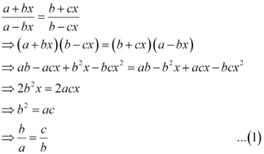

From (1) and (2), we obtain

Thus, a, b, c, and d are in G.P.
Question 8: Let S be the sum, P the product and R the sum of reciprocals of n terms in a G.P. Prove that P2Rn = Sn
ANSWER : Let the G.P. be a, ar, ar2, ar3, … arn – 1…
According to the given information,
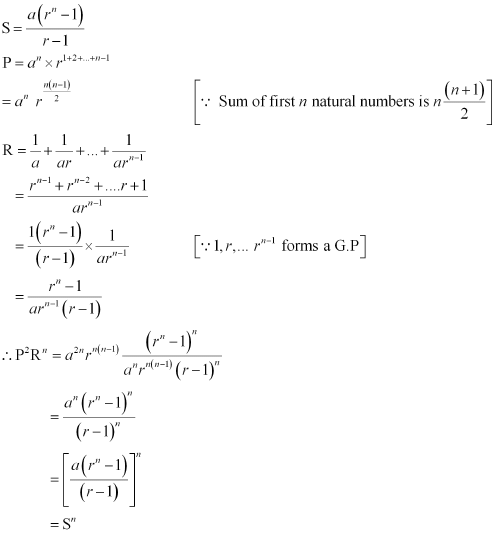
Hence, P2 Rn = Sn
Question 9: The pth, qth and rth terms of an A.P. are a, b, c respectively. Show that
ANSWER : Let t and d be the first term and the common difference of the A.P. respectively.
The nth term of an A.P. is given by, an = t + (n – 1) d
Therefore,
ap = t + (p – 1) d = a … (1)
aq = t + (q – 1)d = b … (2)
ar = t +(r – 1) d = c … (3)
Subtracting equation (2) from (1), we obtain
(p – 1 – q +1) d = a – b
⇒ (p – q) d = a – b

Subtracting equation (3) from (2), we obtain
(q – 1 – r + 1) d = b – c
⇒ (q – r) d = b – c

Equating both the values of d obtained in (4) and (5), we obtain
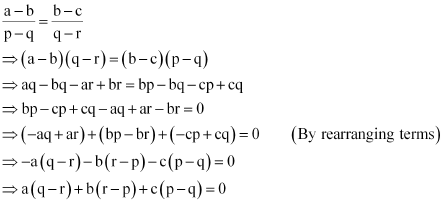
Thus, the given result is proved.
Question 10: If a  are in A.P., prove that a, b, c are in A.P.
are in A.P., prove that a, b, c are in A.P.
ANSWER : It is given that a  are in A.P.
are in A.P.
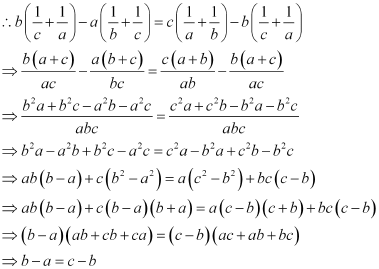
Thus, a, b, and c are in A.P.
Question 11: If a, b, c, d are in G.P, prove that  are in G.P.
are in G.P.
ANSWER : It is given that a, b, c,and d are in G.P.
∴b2 = ac … (1)
c2 = bd … (2)
ad = bc … (3)
It has to be proved that (an + bn), (bn + cn), (cn + dn) are in G.P. i.e.,
(bn + cn)2 = (an + bn) (cn + dn)
Consider L.H.S.
(bn + cn)2 = b2n + 2bncn + c2n
= (b2)n+ 2bncn + (c2) n
= (ac)n + 2bncn + (bd)n [Using (1) and (2)]
= an cn + bncn+ bn cn + bn dn
= an cn + bncn + an dn + bn dn [Using (3)]
= cn (an + bn) +dn (an + bn)
= (an + bn) (cn + dn)
= R.H.S.
∴ (bn + cn)2 = (an + bn) (cn + dn)
Thus, (an + bn), (bn + cn), and (cn + dn) are in G.P.
Question 12: If a and b are the roots of  are roots of
are roots of  , where a, b, c, d, form a G.P. Prove that (q + p): (q – p) = 17:15.
, where a, b, c, d, form a G.P. Prove that (q + p): (q – p) = 17:15.
ANSWER : It is given that a and b are the roots of x2 – 3x + p = 0
∴ a + b = 3 and ab = p … (1)
Also, c and d are the roots of 
∴c + d = 12 and cd = q … (2)
It is given that a, b, c, d are in G.P.
Let a = x, b = xr, c = xr2, d = xr3
From (1) and (2), we obtain
x + xr = 3
⇒ x (1 + r) = 3
xr2 +xr3 =12
⇒ xr2 (1 + r) = 12
On dividing, we obtain
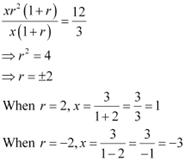
Case I:
When r = 2 and x =1,
ab = x2r = 2
cd = x2r5 = 32

Case II:
When r = –2, x = –3,
ab = x2r = –18
cd = x2r5 = – 288

Thus, in both the cases, we obtain (q + p): (q – p) = 17:15
Question 13: The ratio of the A.M and G.M. of two positive numbers a and b, is m: n. Show that 
ANSWER : Let the two numbers be a and b.
A.M  and G.M. =
and G.M. = 
According to the given condition,
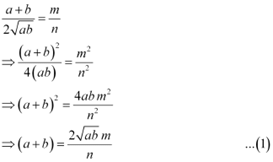
Using this in the identity (a – b)2 = (a + b)2 – 4ab, we obtain

Adding (1) and (2), we obtain

Substituting the value of a in (1), we obtain
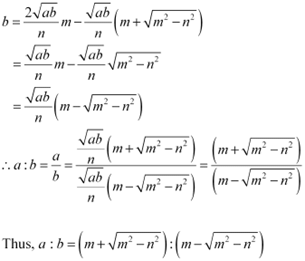
Question 14: If a, b, c are in A.P,; b, c, d are in G.P and  are in A.P. prove that a, c, e are in G.P.
are in A.P. prove that a, c, e are in G.P.
ANSWER : It is given that a, b, c are in A.P.
∴ b – a = c – b … (1)
It is given that b, c, d, are in G.P.
∴ c2 = bd … (2)
Also,  are in A.P.
are in A.P.

It has to be proved that a, c, e are in G.P. i.e., c2 = ae
From (1), we obtain

From (2), we obtain

Substituting these values in (3), we obtain
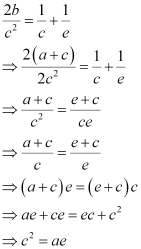
Thus, a, c, and e are in G.P.
Question 15: Find the sum of the following series up to n terms:
(i) 5+ 55 +555 …
(ii) .6 + .66 + .666 …
ANSWER : (i) 5 +55 +555 …
Let Sn = 5+ 55+555 ….. to n terms
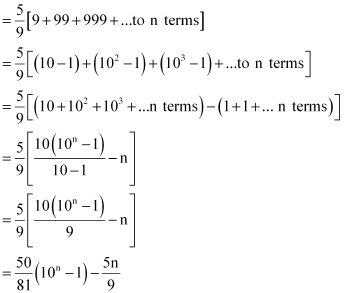
(ii) .6 +.66 +.666 …
Let Sn = 06. +0.66 +0.666 … to n terms
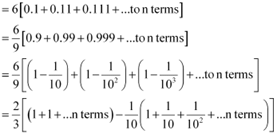

Question 16: Find the 20th term of the series 2 × 4+ 4 × 6 +6 × 8 … n terms.
ANSWER : The given series is 2 × 4 + 4 × 6 + 6 × 8 … n terms
∴ nth term = an = 2n × (2n + 2) = 4n2 + 4n
a20 = 4 (20)2 + 4(20) = 4 (400) + 80 = 1600 + 80 = 1680
Thus, the 20th term of the series is 1680.
Question 17: Find the sum of the first n terms of the series: 3 + 7 + 13 + 21 + 31 …
ANSWER : The given series is 3 + 7 + 13 + 21 + 31 …
S = 3 + 7 + 13 + 21 + 31 … +an–1 + an
S = 3 + 7 + 13 + 21 …. +an – 2 + an – 1 + an
On subtracting both the equations, we obtain
S – S = [3 + (3 + 7 + 13 + 21 + 31 … +an–1 + an)] – [(3 + 7 + 13 + 21 + 31 … + an–1) + an]
S – S = 3 + [(7 – 3) +(13 – 7)+ (21 – 13) … +(an – an–1)] – an
0 = 3 + [4 + 6 + 8 … +(n –1) terms] – an
an = 3 + [4 + 6 + 8 … +(n –1) terms]

Question 18: If S1, S2, S3 are the sum of first n natural numbers, their squares and their cubes, respectively, show that 
ANSWER : From the given information,

Thus, from (1) and (2), we obtain 
Question 19: Find the sum of the following series up to n terms:
ANSWER : The nth term of the given series is 
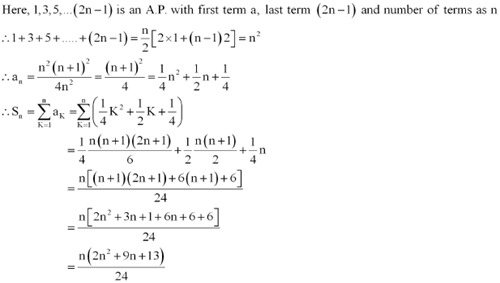
Question 20: Show that 
ANSWER : nth term of the numerator = n(n + 1)2 = n3 + 2n2 + n
nth term of the denominator = n2(n + 1) = n3 + n2
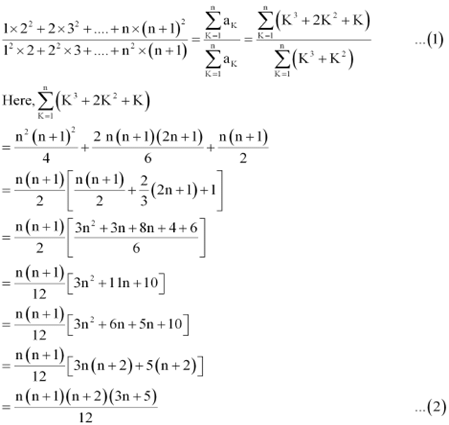


From (1), (2), and (3), we obtain
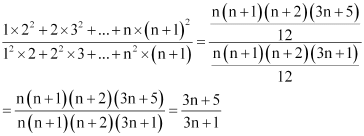
Thus, the given result is proved.
Question 21: A farmer buys a used tractor for Rs 12000. He pays Rs 6000 cash and agrees to pay the balance in annual installments of Rs 500 plus 12% interest on the unpaid amount. How much will be the tractor cost him?
ANSWER : It is given that the farmer pays Rs 6000 in cash.
Therefore, unpaid amount = Rs 12000 – Rs 6000 = Rs 6000
According to the given condition, the interest paid annually is
12% of 6000, 12% of 5500, 12% of 5000, …, 12% of 500
Thus, total interest to be paid = 12% of 6000 + 12% of 5500 + 12% of 5000 … + 12% of 500
= 12% of (6000 + 5500 + 5000 … +500)
= 12% of (500 + 1000 + 1500 … + 6000)
Now, the series 500, 1000, 1500 … 6000 is an A.P. with both the first term and common difference equal to 500.
Let the number of terms of the A.P. be n.
∴ 6000 = 500 + (n – 1) 500
⇒ 1 + (n – 1) = 12
⇒ n = 12
∴Sum of the A.P 
Thus, total interest to be paid = 12% of (500 + 1000 + 1500 … +6000)
= 12% of 39000 = Rs 4680
Thus, cost of tractor = (Rs 12000 + Rs 4680) = Rs 16680
Question 22: Shamshad Ali buys a scooter for Rs 22000. He pays Rs 4000 cash and agrees to pay the balance in annual installment of Rs 1000 plus 10% interest on the unpaid amount. How much will the scooter cost him?
ANSWER : It is given that Shamshad Ali buys a scooter for Rs 22000 and pays Rs 4000 in cash.
∴Unpaid amount = Rs 22000 – Rs 4000 = Rs 18000
According to the given condition, the interest paid annually is
10% of 18000, 10% of 17000, 10% of 16000 … 10% of 1000
Thus, total interest to be paid = 10% of 18000 + 10% of 17000 + 10% of 16000 … + 10% of 1000
= 10% of (18000 + 17000 + 16000 … + 1000)
= 10% of (1000 + 2000 + 3000 … + 18000)
Here, 1000, 2000, 3000 … 18000 forms an A.P. with first term and common difference both equal to 1000.
Let the number of terms be n.
∴ 18000 = 1000 + (n – 1) (1000)
⇒ n = 18

∴ Total interest paid = 10% of (18000 + 17000 + 16000 … + 1000)
= 10% of Rs 171000 = Rs 17100
∴Cost of scooter = Rs 22000 + Rs 17100 = Rs 39100
Question 23: A person writes a letter to four of his friends. He asks each one of them to copy the letter and mail to four different persons with instruction that they move the chain similarly. Assuming that the chain is not broken and that it costs 50 paise to mail one letter. Find the amount spent on the postage when 8th set of letter is mailed.
ANSWER : The numbers of letters mailed forms a G.P.: 4, 42, … 48
First term = 4
Common ratio = 4
Number of terms = 8
It is known that the sum of n terms of a G.P. is given by

It is given that the cost to mail one letter is 50 paisa.
∴Cost of mailing 87380 letters  = Rs 43690
= Rs 43690
Thus, the amount spent when 8th set of letter is mailed is Rs 43690.
Question 24: A man deposited Rs 10000 in a bank at the rate of 5% simple interest annually. Find the amount in 15th year since he deposited the amount and also calculate the total amount after 20 years.
ANSWER : It is given that the man deposited Rs 10000 in a bank at the rate of 5% simple interest annually.
∴ Interest in first year 
∴Amount in 15th year = Rs 
= Rs 10000 + 14 × Rs 500
= Rs 10000 + Rs 7000
= Rs 17000
Amount after 20 years = 
= Rs 10000 20 × Rs 500
= Rs 10000 + Rs 10000
= Rs 20000
Question 25: A manufacturer reckons that the value of a machine, which costs him Rs 15625, will depreciate each year by 20%. Find the estimated value at the end of 5 years.
ANSWER : Cost of machine = Rs 15625
Machine depreciates by 20% every year.
Therefore, its value after every year is 80% of the original cost i.e., 4/5 of the original cost.
∴ Value at the end of 5 years =  = 5 × 1024 = 5120
= 5 × 1024 = 5120
Thus, the value of the machine at the end of 5 years is Rs 5120.
Question 26: 150 workers were engaged to finish a job in a certain number of days. 4 workers dropped out on second day, 4 more workers dropped out on third day and so on. It took 8 more days to finish the work. Find the number of days in which the work was completed.
ANSWER : Let x be the number of days in which 150 workers finish the work.
According to the given information,
150x = 150 + 146 + 142 +…. (x + 8) terms
The series 150 + 146 + 142 +…(x + 8) terms is an A.P. with first term 146, common difference –4 and number of terms as (x + 8)
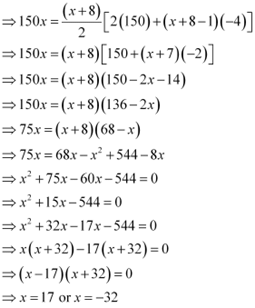
However, x cannot be negative.
∴x = 17
Therefore, originally, the number of days in which the work was completed is 17.
Thus, required number of days = (17 + 8) = 25
|
176 videos|582 docs|160 tests
|
FAQs on NCERT Solutions Class 11 Maths Chapter 8 - Sequence And Series
| 1. What are sequences and series in mathematics? |  |
| 2. How do you identify an arithmetic sequence? |  |
| 3. What is the formula for the nth term of an arithmetic sequence? |  |
| 4. How do you find the sum of an arithmetic series? |  |
| 5. What is the difference between an arithmetic sequence and a geometric sequence? |  |
















